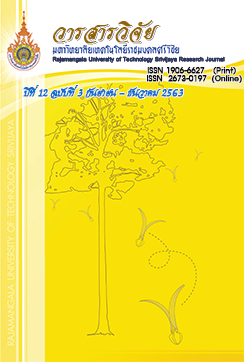Optimizing Conditions for Using Lectin as a Marker for Banana Shrimp Response against Pathogenic Challenge
Keywords:
Lectin, Fenneropenaeus merguiensis, pathogen, Vibrio spp., WSSVAbstract
Lectin is one of pattern recognition proteins which plays an important role in crustacean innate immunity. It is capable of recognizing specific carbohydrates on the cell surfaces of invading microorganisms. In this study, in order to optimize conditions for using lectin as a marker for Banana shrimp response against pathogenic challenge, changes in hemagglutinating activity (HA) of lectin in the hemolymph of shrimp injected with pathogens were investigated. ELISA was also developed to quantify lectin contents in the hemolymph with the sensitivity as low as 12 ng per assay. Among the challenge of shrimp with various amounts of pathogenic bacterium, the injection with Vibrio harveyi (5×107 cells) resulted in a significant increase in HA and specific HA of hemolymph lectin to the maximum level at 12 h post-injection of 6.8 and 10.5 folds, respectively and then decreased. It was agreed well with a change in levels of lectin contents determined by ELISA while total protein in the hemolymph was reduced from injection. The changes in hemolymph HA and lectin contents indicated the significant response of shrimp against pathogenic V. harveyi and toward the appropriate amount of the challenged bacterium since HAs were more or less the same in the hemolymph of shrimp during injection with saline, inactive V. harveyi or non-pathogenic Vibrio cholerae. When each shrimp was injected with white spot syndrome virus (WSSV) 10-7 of stock, HA of hemolymph lectin increased to the highest level (3.8 folds) at 18 h post-injection and then declined. Altogether, it is concluded that changes in lectin levels in the hemolymph could be used as a marker for shrimp response toward invading pathogens, indicating the appropriate amount for pathogenic challenge that was V. harveyi 5×107 cells or WSSV 10-7 of stock
References
Bradford, M.M. 1976. A rapid and sensitive method for the quantitation of microgram quantities of protein utilizing the principle of protein-dye binding. Analytical Biochemistry 72: 248-254.
Chattopadhyay, T., Guha, A.K. and Chatterjee, B.P. 1996. Novel antimicrobial activity of scyllin, a haemolymph lectin of the edible crab Scylla serrata. Biomedical Letters 53: 29-40.
Goldstein, I.J., Huges, R.C., Monsigny, M., Osawa, T. and Sharon, N. 1980. What should be called a lectin. Nature 285: 66.
Jayasree, S., Selvam, G.S. and Thomas, S. 2000. Development of an enzyme-linked immunosorbent assay (ELISA) for agglutinin, and antibacterial protein of the shrimp Fenneropenaeus indicus. Journal of Crustacean Biology 20: 621-627.
Jiravanichpaisal, P. and Miyazaki, T. 1994. Histopathology, biochemistry, and pathogenicity of Vibrio harveyi infecting black tiger prawn, Penaeus monodon. Journal of Aquatic Animal Health 6: 27-35.
Kwankaew, P., Praparatana, R., Runsaeng, P. and Utarabhand, P. 2018. An alternative function of C-type lectin comprising low-density lipoprotein receptor domain from Fenneropenaeus merguiensis to act as a binding receptor for viral protein and vitellogenin. Fish & Shellfish Immunology 74: 295-308.
Ling, E. and Yu, X. 2006. Cellular encapsulation and melanization are enhanced by immulectins, pattern recognition receptors from the tobacco hornworm Manduca sexta. Developmental and Comparative Immunology 30: 289-299.
Luo, R. 1996. S tudy on the contents of serum protein and glucose in the hemolymph of the shrimp Penaeus chinensis. Journal of Oceanology and Limnology 27(5): 476-480.
Luo, T., Yang, H., Li, F., Zhang, X. and Xu, X. 2006. Purification, characterization and cDNA cloning of a novel lipopolysaccharide-binding lectin from the shrimp Penaeus monodon. Developmental and Comparative Immunology 30: 607-617.
Ratanapo, S. and Chulavatnatol, M. 1992. Monodin-induced agglutination of Vibrio vulnificus, a major infective bacterium in black tiger prawn (Penaeus monodon). Comparative Biochemistry and Physiology 102: 855-859.
Rittidach, W., Paijit, N. and Utarabhand, P. 2007. Purification and characterization of a lectin from the banana shrimp Fenneropenaeus merguiensis hemolymph. Biochimica et Biophysica Acta 1770: 106-114.
Runsaeng, P., Puengyam, P. and Utarabhand, P. 2017. A mannose-specific C-type lectin from Fenneropenaeus merguiensis exhibited antimicrobial activity to mediate shrimp innate immunity. Molecular Immunology 92: 87-98.
Downloads
Published
How to Cite
Issue
Section
License
The content and information in the article published in Journal of Rajamangala University of Technology Srivijaya It is the opinion and responsibility of the author of the article. The editorial journals do not need to agree. Or share any responsibility.







